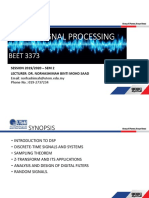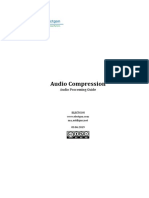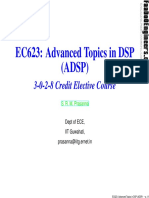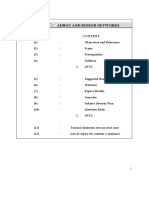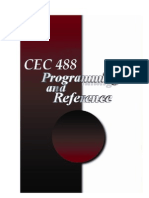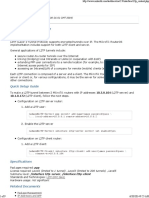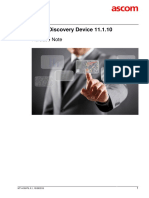Speech and Audio Coding
Uploaded by
hachanSpeech and Audio Coding
Uploaded by
hachanSignal Processing for Communications
An Introduction to Advanced Technology and Research for
Undergraduates
Related Technologies and Applications:
Digital Cell Phones
Technologies for Cable Modems and Wi-Fi
Secure Military Communications
April 14, 2006, 9:45am-12pm, SCOB 101
Lectures and Modules for Undergraduates on:
Speech and Audio Coders, Andreas Spanias
Channel Coders, Tolga Duman
Time-Varying Signal Processing, Antonia Papandreou-Suppappola
Multcarrier and OFDM Systems, Cihan Tepedelenlioglu
Sponsored by the NSF Combined Research and Curriculum Development Grant 0417604
April 2006 Copyright (c) 2006 - Andreas Spanias II-1
Pedagogiesfor transition of
research to UG curriculum Summer Freshman
DEMO MODULES (DM) and Sophomore
Research Camps
ASU J-DSP Technology for
on-line Java Computer Labs
SS EEE 303 RDA EEE 350
SMALL 1-LECTURE/LAB MODULES (SM)
1lecture/1exercise
4 Module Summaries
to inject in 303, 350, 407, 455
DSP EEE 407 CS EEE 455
LARGE-6-LECTURE 498 MODULES (LM)
•Source Coding (6 lect/1 lab
-
EEE 498
•Channel Coding (6 lect/1 lab
-
Intro to
•Multi-carrIer(6 lect/ 1 lab-
SP-COM
•Time-varying signaling (6 lect/1 lab
-
Research
SP-COM Research
drawn from ASU SP -COM research Feedback/
Activities and from research
Improvement
published work from other universities
April 2006 Copyright (c) 2006 - Andreas Spanias II-2
Wireless Communications
(cell phone appl.)
Input Source Channel
Modulator
Speech Coder Coding
Channel
Output Source Channel
Demodulator
Speech Decoding Decoding
April 2006 Copyright (c) 2006 - Andreas Spanias II-3
Speech and Audio Coding for Mobile and
Multimedia Applications
CRCD Activity, April 14, 2006
by
Andreas Spanias, Professor
DSP and Speech Processing Labs.
Dept. of Electrical Engineering
Arizona State University
Tempe, AZ 85287-5706
email: spanias@asu.edu
http://www.eas.asu.edu/~spanias
April 2006 Copyright (c) 2006 - Andreas Spanias II-4
Topics
1. The Speech Coding Problem
2. Speech Processing Analysis-Synthesis Algorithms
3. Historical Perspective on Algorithmic Research
4. The Standards on Speech Coding
5. Algorithm Examples
6. Research / Remarks
April 2006 Copyright (c) 2006 - Andreas Spanias II-5
Digital Speech
s (n) = s (nT ) = sα (t ) |t = nT
- Can be Manipulated with Software
-Opportunities for Encryption and Enhanced Privacy
Why Digital
Speech? -Stored with High Fidelity
-Error Control
-Mixing Voice/Data/Video- Multimedia
April 2006 Copyright (c) 2006 - Andreas Spanias II-6
Continuous vs Discrete-time (digital) Speech
Continuous-time (analog) Signal Discrete-time (digital) signal
x(t) x(n)
0 T 2T ...
t n
x(t) Q x(n)
A signal that is bandlimited to B must be sampled at a rate of fs, f s ≥ 2B
Telephone Speech is typically bandlimited to 3.2 kHz and sampled at 8kHz
April 2006 Copyright (c) 2006 - Andreas Spanias II-7
Quantization Considerations
For uncompressed telephone speech : 8 bits per sample
8000 samples per second
for a total of 8000 x 8 = 64 kilo bits per second (kbits/s)
PCM 64 kbits is often used as a reference for comparison
To transmit this signal using a basic binary signaling scheme
we need at least 32 kHz of bandwidth
April 2006 Copyright (c) 2006 - Andreas Spanias II-8
Speech Coding
Speech coding or Speech compression is the field concerned
with obtaining compact digital representations of voice
signals for the purpose of efficient transmission or storage.
Speech coding involves sampling and amplitude
quantization.
The objective of speech coding is to represent speech with
a minimum number of bits while maintaining its perceptual
quality.
April 2006 Copyright (c) 2006 - Andreas Spanias II-9
Medium, Low, and Very-low Rate Speech Coding
The speech methods discussed in this course are those intended
for digital speech communications where speech is generally
bandlimited to 4 kHz ( or 3.2 kHz ) and sampled at 8 kHz.
medium-rate coding - the range of 8 - 16 kbits/s
low-rate the range below 8 kbits/s and down to 2.4 kbits/s
very-low-rate the range below 2.4 kbits/s
Remark: Cellular, Voice-Over-IP and speech streaming
applications typically use low-rate coders
April 2006 Copyright (c) 2006 - Andreas Spanias II-10
Historical Perspective
The First Vocoder - Dudley’s Channel Vocoder
Analysis Synthesis
Pitch Channel
Frequency Frequency Filter
Discriminator Meter 0-25~ Pitch
Oscillator
Noise
Filter
EQLZR Modulator
Spectrum Channels 0-300~
Filter Filter
0-300~ 0-25~
EQLZR
A total of ten channels
H. Dudley, "Remaking Speech," J. Acoust. Soc. Am., Vol. 11, p. 169, 1939.
H. Dudley, "The Vocoder," Bell Labs. Record., 17, p. 122, 1939.
April 2006 Copyright (c) 2006 - Andreas Spanias II-11
Voiced and Unvoiced Speech
1.0 Time domain speech segment 50
fundamental
TAPE TIME: 8014 frequency
20 Formant Structure
0.0
Amplitude
0
Magnitude (dB)
-1.0 -20
0 8 16 24 32 0 1 2 3 4
Time (mS) Frequency (KHz)
1.0 Time domain speech segment 40
TAPE TIME: 3840
20
0.0
0
Amplitude
Magnitude (dB)
-1.0 -30
0 8 16 24 32 0 1 2 3 4
Time (mS) Frequency (KHz)
April 2006 Copyright (c) 2006 - Andreas Spanias II-12
Fine (Pitch) and Formant Structure of the
Short-time Speech Spectrum
Fine Harmonic Structure : reflects the quasi-periodicity of
speech and is attributed to the vibrating vocal chords.
Note the narrow peaks
Formant Structure (Spectral Envelope): is due to the
interaction of the source and the vocal tract. The vocal tract
consists of the pharynx and the mouth cavity.
Note the envelope peaks
April 2006 Copyright (c) 2006 - Andreas Spanias II-13
Simple Speech Synthesis Model (2)
Requires “hard” (binary)
Pitch τ
info voicing
V/UV
VOCAL SYNTHETIC
gain TRACT
SPEECH
FILTER
b0
H ( z) = M
1+ ∑ai z −i
i =1
April 2006 Copyright (c) 2006 - Andreas Spanias II-14
H(z) typically estimated using short term linear prediction
The Levinson-Durbin Algorithm
The recursive coefficient update for the m-th order predictor
{ m = 1,2,..., p}
∈f (O ) = r ss (O )
m −1
r ss (m ) − ∑ a i (m − 1 )r ss (m − i )
order a m (m ) = i =1
∈ f (m − 1 )
ai (m ) = ai (m − 1) − am (m )am −i (m − 1) , 1 ≤ i ≤ m -1
index ∈f (m ) = (1 − (a m (m ))2 )∈ f (m − 1)
April 2006 Copyright (c) 2006 - Andreas Spanias II-15
Speech Analysis-by-Synthesis (closed-loop)
Frequency responses Synthesis speech is
of the two synthesis
filters
forced to match i/p speech
s(n)
+
^
Select + + s(n)
-
or Form gain
Excitation
+ +
A (z) A(z)
L
LTP LP
MSE W(z)
April 2006 Copyright (c) 2006 - Andreas Spanias II-16
Code Excited Linear Prediction (2)
The Nx1 error vector
e c (k ) = s w − sˆ w0 − g k sˆ w (k )
sˆw0 output due to the initial filter state,
Minimizing ∈ c (k ) = e cT (k )e c (k ) w.r.t. gk we get
swT sˆw (k )
gk = T
sˆw (k )sˆw (k )
April 2006 Copyright (c) 2006 - Andreas Spanias II-17
Code Excited Linear Prediction (3)
∈ c (k ) = s s w − T w
T sˆ (k ) (s T
w )
2
sˆ w (k )sˆ w (k )
w
The k-th excitation vector, X c (k ) , that minimizes ∈c (k) is selected
closed-loop analysis is used for LTP parameters; range of values for τ
within the integers 20 to 147
M.R. Schroeder and B. Atal, "Code-Excited Linear Prediction (CELP): High Quality Speech at
Very Low Bit Rates," Proc. ICASSP-85, p. 937, Tampa, Apr. 1985.
April 2006 Copyright (c) 2006 - Andreas Spanias II-18
LTP excited by a random signal creates pseudo-periodicity
1
1 − 0.95 z −30
Impulse response Frequency response
Magnitude Response (dB)
10
-10
0 0.5 0.9 1
Normalized frequency (Nyquist = 1)
April 2006 Copyright (c) 2006 - Andreas Spanias II-19
Perceptual Weighting Filter (2)
30
Short Term
Predictor
25
H (z ) =
20 1
10
15 1 − ∑ ai z −i
i =1
10
-5
Perceptual Filter χ=0.9
-10 p
1 − ∑ ai z −i
W (z ) =
-15
0 100 200 300 400 500 600 i =1
p
1 − ∑ γ i ai z −i
i =1
April 2006 Copyright (c) 2006 - Andreas Spanias II-20
Performance and Computational Complexity
A speech coding algorithm is designed and evaluated
based on:
1. Bit rate
2. The quality of reconstructed (“coded”) speech
3. The complexity of the algorithm
4. The end-to-end delay
April 2006 Copyright (c) 2006 - Andreas Spanias II-21
Subjective Speech Quality
Broadcast
Broadcast wideband speech refers to high quality
“commentary” speech at rates above 64 kbits/s.
Network or toll
Toll or Network quality refers to quality comparable
to the classical analog speech (200-3200 Hz)
Communications
Communications quality implies somewhat degraded
speech quality but adequate for cellular communications.
Synthetic
Synthetic speech is usually intelligible but can be
unnatural and associated with a loss of speaker recognizability.
April 2006 Copyright (c) 2006 - Andreas Spanias II-22
The Mean Opinion Score
MOS Scale Speech Quality
1 Bad
2 Poor
3 Fair
4 Good
5 Excellent
April 2006 Copyright (c) 2006 - Andreas Spanias II-23
The Mean Opinion Score (2)
The MOS range relates to speech quality as follows :
MOS 4.0 - 4.5 : network or toll quality
MOS 3.5 - 4.0 : communications quality
MOS 2.5 - 3.5 : synthetic quality
Remarks : MOS ratings may differ significantly from test to
test and hence they are not absolute measures for the
comparison of different coders.
April 2006 Copyright (c) 2006 - Andreas Spanias II-24
Wideband CDMA
Objective to meet IMT 2000 requirements (at least 144 Kb/s in a vehicular
environment, 384 Kb/s in a pedestrian environment, and 2048 Kb/s in an indoor
office environment)
To supports next generation data services envisioned up to 2MB/s (Full coverage
and mobility for 144 Kb/s, preferably 384 Kb/s - Limited coverage and mobility
for 2 Mb/s)
Enhanced Voice Services (audioconferencing & voice mail)
Concurrent high-quality video/audio
Backward compatible with IS-95B
high security & low power
Significantly enhanced version of EVRC for voice services
- http://www.comsoc.org/pubs/surveys/4q98issue/prasad.html
- D. Knisely et al, Evolution of Wireless Data Services: IS-95 to CDMA 2000, IEEE Communications Magazine, pp. 140-149, October 1998
- IS-95 CDMA and cdma2000: Cellular/PCS Systems Implementation, 1/e, Vijay K. Garg, University of Illinois, Chicago, Illinois Published
December, 1999 by Prentice Hall PTR (ECS Professional)
April 2006 Copyright (c) 2006 - Andreas Spanias II-25
GSM Adaptive Multirate Coder
Adjusts its bit-rate according to network load
Rates 12.2, 10.2, 7.95, 6.7, 5.9, 5.15, 4.75kb/s
Based on CELP with 20 ms frame and 5 ms subframe
Multirate-ACELP with 10th order short-term LPC and perceptual
weighting (uses levinson)
Encodes LSPs using split VQ
An open loop LTP is first obtained and refined by closed loop
Highest bit rate provides toll quality & half rate provides communications
quality
- ETSI TS 126 090 V.3.1.0 2000-01 - AMR SPEECH CODEC TRANSCODING FUNCTIONS 3G-TS 26.090 Technical Specification
- R. Ekudden, R. Hagen, I. Johansson, and J. Svedburg, "The Adaptive Multi-Rate speech coder, Proc. IEEE Workshop on
Speech Coding, pp. 117-119, 1999
April 2006 Copyright (c) 2006 - Andreas Spanias II-26
The Selectable Mode Vocoder
• Algorithm to provide higher quality, flexibility, and capacity over existing IS-96C, IS-
127 EVRC, and IS-733 (that replaced IS-96C but working at higher average rate)
• The Conexant SMV algorithm became the core technology for 3G CDMA (core SMV
algorithm to be refined in the interim by participating companies according to the
publication below)
• Based on 4 codecs: full rate at 8.5 kbps, half rate at 4 kbps, quarter rate at 2 kbps, and
eighth rate at 800 bps
• Pre-processing includes noise suppression similar to IS 127 EVRC
• Full rate and half rate based on Conexants eXtended CELP (eX-CELP) a core
technology also used in the ITU G.4 Conexant submission to ITU-4
• Performed better than IS-733 and IS-127 in tests with and without background noise
• Scored as high as 4.1 MOS at full rate with clean speech. Performed very well with
background noise
REFERENCES:
[1] “The SMV algorithm selected for TIA and 3GPP2 for CDMA applications,” conference paper by Conexant systems, Y.Gao, E.
Schlomot, A. Benyassine, J. Thyssen, H. Su, and C Murgia (portions published at ICASSP-2001)
April 2006 Copyright (c) 2006 - Andreas Spanias II-27
STANDARDS AT A GLANCE
• ITU Wideband Coding
– G.722 Coding of 7 kHz speech at 64, 56,48 kbps - Sub-band ADPCM
– G.WB1 Coding of 7 kHz speech at 32/ 24 kbps - Combined Transform and CELP coding
– G.WB2 Coding of 7 kHz speech at 16 kbps or less (ongoing)
• ITU Telephony
– G.711 PCM (64 kbps) late 60’s
– G.726 ADPCM (32/40/ 24/16 kbps) 1988
– G.728 LD-CELP coding (16 kbps) 1992
– G.723.1 True Speech (5.3/6.3 kbps) 1995
– G.729 CS-ACELP (8/12.8/6.4 kbps) 1996 and Annex in 1998
– G.4kbps Toll quality at 4 kbps (on going)
• Non-ITU
– MPEG1/Audio (includes MP3), 1991
– MPEG2/Audio: 64 kbps (1992)
– MPEG4/Audio: audio/speech coding at bit rates between 64 and 2 kbps (1998)
– MPEG7/Audio: audio/speech/MIDI coding (ongoing)
April 2006 Copyright (c) 2006 - Andreas Spanias II-28
STANDARDS AT A GLANCE (2)
• TIA
– CDMA
• IS96 8,4,2 kbps Q-CELP (Qualcomm CELP, 1992)
• IS127 8.55, 4, 0.8 kbps EVRC (Enhanced Variable. Rate Coder, 1996)
• IS733 13.3, 6.2, 2.7, 1 kbps VRC (Variable Rate Coder, 1998)
• 3GPP2 0.8-8.55 kbps SMV (Selectable Mode Vocoder, 2001)
– TDMA
• IS54 7.95 kbps VSELP (Vector-Sum Excitation Linear.Predictor., 1989)
• IS641 7.4 kbps CELP (Similar to EFR but at lower rate, 1997)
– PCS1800 (GSM variant working at 1800 MHz)
• IS136-410 12.2 kbps US1 (1999)
• ETSI (GSM):
– 13 kbps RPE-LTP (Full rate GSM, 1988)
– 6.5 kbps VSELP (Half-rate GSM, 1993)
– 12.2 kbps EFR (Enhanced full-rate GSM, 1996)
– 12.2 - 4.75 kbps AMR (Adaptive Multi Rate, 1999)
• ARIB Japan
– Full-rate PDC (Personal Digital Communication) 6.7 kbps VSELP
– Half-rate PDC 3.45 kbps Multimode CELP`
April 2006 Copyright (c) 2006 - Andreas Spanias II-29
Vocoder/Waveform/Hybrid
MOS PCM
Hybrid Coders ADPCM
1-5 SMV
CELP
Waveform Coders
MELP
LPC10e
Vocoders
1 2 4 8 16 32 64
Bit rate (kbps))
April 2006 Copyright (c) 2006 - Andreas Spanias II-30
PERFORMANCE OF SOME STANDARDIZED ALGORITHMS
Algorithm Bit Rate MOS Complexity Framesize (ms)
(kbits/s) (MIPS)
PCM G.711 64 4.3 0.01 0
+
ADPCM G.726 32 4.1 2 0.125
SBC G.722 48/56/64 4.1 5 0.125
LD-CELP G.728 16 4 ~30 0.625
CS-ACELP G.729 8 4 ~20 10
CS-ACELP-A G.729 8 3.76 11 10
MPC-MLQ G.723.1 6.3/5.3 3.98/3.7 ~16 30
GSM FR RPE-LTP 13 3.7 (ave) 5 20
GSM EFR 13 4 14 20
GSM HR VSELP 6.3 ~3.4 14 20
IS-54 VSELP 8 3.5 14 20
IS-641 EFR 8 3.8 14 20
Conexant eX-CELP SMV 8.55/4/2/0.8 ~4.1 (8.55) ~20 MIPS 20
IS-96 QCELP 1.2/2.4/4.8/9.6 3.33 (9.6) 15 20
IS-127 EVRC 1.2/4.8/9.6 ~3.8 (9.6) 20 20
PDC VSELP 6.3 3.5 14 20
PDC PCI-CELP 3.45 ~3.4 ~48 40
FS 1015 – LPC 10e 2.4 2.3 7 22.5
FS 1016 – CELP 4.8 4.8 3.2 16 30
MELP 2.4 3.2 ~30 22.5
Inmarsat-B APC 9.6/12.8 ~3.1/3.4 10 20
Inmarsat-M IMBE 6.3 3.4 ~13 20
April 2006 Copyright (c) 2006 - Andreas Spanias II-31
Research in Speech and Audio Coding at Arizona State
Speech Coding
S. Ahmadi and A. Spanias, “Algorithms for Low-bit rate sinusoidal coding,” Speech
Communications, Vol. 34(2001), pp.369-390, June 2001 - Research funded by Intel Corp.
Perceptual LPC, ICASSP 05, Atti Venkatraman, NSF
Audio Coding
Selection of sinusoids based on perceptual criteriaT. Painter and A. S. Spanias, " Sinusoidal
Analysis-Synthesis of Audio using Perceptual Criteria,” Proc.. IEEE International Symposium on
Circuits and Systems (ISCAS-02), Phoenix, May 2002. - Research funded by Intel Corporation
Enhancing the Bandwidth of Speech Coders, ISCAS05, Visar Berisha, NSF
2002 Donald G. Fink Prize Paper Award by IEEE Board of Directors -
Award Wining Paper
T. Painter and A. S. Spanias, “Perceptual coding of digital audio,” Proc. of the IEEE, vol. 88, no.4 , pp. 451-
513, Apr. 2000. It was recognized by the IEEE Board of Directors with the prestigious 2002 IEEE Donald G.
Fink Prize Paper Award. (A. Spanias principal investigator and Ph.D. advisor of T. Painter)
April 2006 Copyright (c) 2006 - Andreas Spanias II-32
You might also like
- Speech Coding: Fundamentals and Applications: ARK Asegawa OhnsonNo ratings yetSpeech Coding: Fundamentals and Applications: ARK Asegawa Ohnson20 pages
- SPARTA McCormackPolitis2019SpartaCompassNo ratings yetSPARTA McCormackPolitis2019SpartaCompass13 pages
- Speech Coding: Fundamentals and Applications: ARK Asegawa OhnsonNo ratings yetSpeech Coding: Fundamentals and Applications: ARK Asegawa Ohnson20 pages
- Ec3492-Digital Signal Processing LaboratoryNo ratings yetEc3492-Digital Signal Processing Laboratory80 pages
- Speech & Audio Processing Part - II: Marc Moonen Dept. E.E./ESAT, K.U.LeuvenNo ratings yetSpeech & Audio Processing Part - II: Marc Moonen Dept. E.E./ESAT, K.U.Leuven22 pages
- Securing Audio Watermarking System Using Discrete Fourier Transform For Copyright ProtectionNo ratings yetSecuring Audio Watermarking System Using Discrete Fourier Transform For Copyright Protection5 pages
- Acoustic & Audio Signal Processing (4 Credits)No ratings yetAcoustic & Audio Signal Processing (4 Credits)2 pages
- Third Semester Courses: Course No. Course Name L-T-P-Credits Year of 10EC7105 Audio Processing 3 - 0 - 0 - 3 2015No ratings yetThird Semester Courses: Course No. Course Name L-T-P-Credits Year of 10EC7105 Audio Processing 3 - 0 - 0 - 3 20152 pages
- DSP Engineer, Systems Engineer, Wireless Design EngineerNo ratings yetDSP Engineer, Systems Engineer, Wireless Design Engineer3 pages
- A Software Tool For Introducing Speech Coding Fundamentals in A DSP CourseNo ratings yetA Software Tool For Introducing Speech Coding Fundamentals in A DSP Course10 pages
- Lesson 2 - Digitizing and Packetizing VoiceNo ratings yetLesson 2 - Digitizing and Packetizing Voice22 pages
- Advanced Signal Processing: Proceedings of The 21st Academic Council of VIT (30.11.2010)No ratings yetAdvanced Signal Processing: Proceedings of The 21st Academic Council of VIT (30.11.2010)2 pages
- Convention Paper 5553: Spectral Band Replication, A Novel Approach in Audio CodingNo ratings yetConvention Paper 5553: Spectral Band Replication, A Novel Approach in Audio Coding8 pages
- Chapter 1: Introduction: Communication Engineering Video Processing Speech/Audio Processing MedicalNo ratings yetChapter 1: Introduction: Communication Engineering Video Processing Speech/Audio Processing Medical4 pages
- Ec8562 Digital Signal Processing Laboratory 1953309632 Ec8562 Digital Signal Processing LabNo ratings yetEc8562 Digital Signal Processing Laboratory 1953309632 Ec8562 Digital Signal Processing Lab81 pages
- Android Handset VoIP Echo Cancellation - 2014 - AASRI ProcediaNo ratings yetAndroid Handset VoIP Echo Cancellation - 2014 - AASRI Procedia5 pages
- Ece4001 Digital-Communication-Systems Eth 1.1 47 Ece4001No ratings yetEce4001 Digital-Communication-Systems Eth 1.1 47 Ece40014 pages
- First IETF Internet Audiocas T: 1 Introductio NNo ratings yetFirst IETF Internet Audiocas T: 1 Introductio N6 pages
- Challenges and Recent Developments in Hearing AidsNo ratings yetChallenges and Recent Developments in Hearing Aids42 pages
- Proj No. Title: A/P Chong Yong Kim A/P Gan Woon SengNo ratings yetProj No. Title: A/P Chong Yong Kim A/P Gan Woon Seng5 pages
- Voice Signal Processing For Speech Synthesis: June 2006No ratings yetVoice Signal Processing For Speech Synthesis: June 20066 pages
- Voice Signal Processing For Speech Synthesis: June 2006No ratings yetVoice Signal Processing For Speech Synthesis: June 20066 pages
- EC623: Advanced Topics in DSP (ADSP) : 3-0-2-8 Credit Elective CourseNo ratings yetEC623: Advanced Topics in DSP (ADSP) : 3-0-2-8 Credit Elective Course19 pages
- Ec8562-Digital Signal Processing Laboratory-1953309632-Ec8562-Digital-Signal-Processing-LabNo ratings yetEc8562-Digital Signal Processing Laboratory-1953309632-Ec8562-Digital-Signal-Processing-Lab80 pages
- Automatic Speech Activity Detection, Source Localization, and Speech Recognition On The Chil Seminar CorpusNo ratings yetAutomatic Speech Activity Detection, Source Localization, and Speech Recognition On The Chil Seminar Corpus4 pages
- Ece2006 Digital-Signal-Processing Eth 1.0 37 Ece2006No ratings yetEce2006 Digital-Signal-Processing Eth 1.0 37 Ece20063 pages
- EE 615: Lecture 1 Multicarrier Communications: Professor Uf TureliNo ratings yetEE 615: Lecture 1 Multicarrier Communications: Professor Uf Tureli53 pages
- The Problem Can Be Translated Into Python With TheNo ratings yetThe Problem Can Be Translated Into Python With The2 pages
- Sakho I. Introduction To Quantum Mechanics 2. 2020 PDFNo ratings yetSakho I. Introduction To Quantum Mechanics 2. 2020 PDF297 pages
- Water Tank 10,000 L 10 Control Panel: Top ViewNo ratings yetWater Tank 10,000 L 10 Control Panel: Top View1 page
- Note That The Equations of Steps 1 and 2No ratings yetNote That The Equations of Steps 1 and 22 pages
- HP 37722A Telecom Analyzer HP 37732A Telecom/datacom AnalyzerNo ratings yetHP 37722A Telecom Analyzer HP 37732A Telecom/datacom Analyzer8 pages
- Technical Note - Loading FortiGate Firmware Image Using TFTPNo ratings yetTechnical Note - Loading FortiGate Firmware Image Using TFTP4 pages
- The Basics of Siemens S7 PLC I - O Addressing - DMC, IncNo ratings yetThe Basics of Siemens S7 PLC I - O Addressing - DMC, Inc4 pages
- AWS Ramp-Up Guide: Architect: For AWS Cloud Architects, Solutions Architects, and EngineersNo ratings yetAWS Ramp-Up Guide: Architect: For AWS Cloud Architects, Solutions Architects, and Engineers2 pages
- Lab 1 Introduction: Network AdministrationNo ratings yetLab 1 Introduction: Network Administration1 page
- Instruction Manual For Power Alert For VMware Servers enNo ratings yetInstruction Manual For Power Alert For VMware Servers en15 pages
- ACS880 - Diode Supply CNTRL Prog - FW Manual - Rev BNo ratings yetACS880 - Diode Supply CNTRL Prog - FW Manual - Rev B126 pages
- Whats New in Dynamics 365 Business CentralNo ratings yetWhats New in Dynamics 365 Business Central22 pages
- Frequently Encountered Problems and SolutionsNo ratings yetFrequently Encountered Problems and Solutions4 pages
- Various Linux Commands in System AdministrationNo ratings yetVarious Linux Commands in System Administration25 pages
- Leica CloudWorx 4.0 For MicroStation - Section I - Basic Commands0% (1)Leica CloudWorx 4.0 For MicroStation - Section I - Basic Commands6 pages
- SNMP Tutorial Part 1 - The MIB, The Manager, The Agents...No ratings yetSNMP Tutorial Part 1 - The MIB, The Manager, The Agents...4 pages
- Speech Coding: Fundamentals and Applications: ARK Asegawa OhnsonSpeech Coding: Fundamentals and Applications: ARK Asegawa Ohnson
- Speech Coding: Fundamentals and Applications: ARK Asegawa OhnsonSpeech Coding: Fundamentals and Applications: ARK Asegawa Ohnson
- Speech & Audio Processing Part - II: Marc Moonen Dept. E.E./ESAT, K.U.LeuvenSpeech & Audio Processing Part - II: Marc Moonen Dept. E.E./ESAT, K.U.Leuven
- Securing Audio Watermarking System Using Discrete Fourier Transform For Copyright ProtectionSecuring Audio Watermarking System Using Discrete Fourier Transform For Copyright Protection
- Third Semester Courses: Course No. Course Name L-T-P-Credits Year of 10EC7105 Audio Processing 3 - 0 - 0 - 3 2015Third Semester Courses: Course No. Course Name L-T-P-Credits Year of 10EC7105 Audio Processing 3 - 0 - 0 - 3 2015
- DSP Engineer, Systems Engineer, Wireless Design EngineerDSP Engineer, Systems Engineer, Wireless Design Engineer
- A Software Tool For Introducing Speech Coding Fundamentals in A DSP CourseA Software Tool For Introducing Speech Coding Fundamentals in A DSP Course
- Advanced Signal Processing: Proceedings of The 21st Academic Council of VIT (30.11.2010)Advanced Signal Processing: Proceedings of The 21st Academic Council of VIT (30.11.2010)
- Convention Paper 5553: Spectral Band Replication, A Novel Approach in Audio CodingConvention Paper 5553: Spectral Band Replication, A Novel Approach in Audio Coding
- Chapter 1: Introduction: Communication Engineering Video Processing Speech/Audio Processing MedicalChapter 1: Introduction: Communication Engineering Video Processing Speech/Audio Processing Medical
- Ec8562 Digital Signal Processing Laboratory 1953309632 Ec8562 Digital Signal Processing LabEc8562 Digital Signal Processing Laboratory 1953309632 Ec8562 Digital Signal Processing Lab
- Android Handset VoIP Echo Cancellation - 2014 - AASRI ProcediaAndroid Handset VoIP Echo Cancellation - 2014 - AASRI Procedia
- Ece4001 Digital-Communication-Systems Eth 1.1 47 Ece4001Ece4001 Digital-Communication-Systems Eth 1.1 47 Ece4001
- Challenges and Recent Developments in Hearing AidsChallenges and Recent Developments in Hearing Aids
- Proj No. Title: A/P Chong Yong Kim A/P Gan Woon SengProj No. Title: A/P Chong Yong Kim A/P Gan Woon Seng
- Voice Signal Processing For Speech Synthesis: June 2006Voice Signal Processing For Speech Synthesis: June 2006
- Voice Signal Processing For Speech Synthesis: June 2006Voice Signal Processing For Speech Synthesis: June 2006
- EC623: Advanced Topics in DSP (ADSP) : 3-0-2-8 Credit Elective CourseEC623: Advanced Topics in DSP (ADSP) : 3-0-2-8 Credit Elective Course
- Ec8562-Digital Signal Processing Laboratory-1953309632-Ec8562-Digital-Signal-Processing-LabEc8562-Digital Signal Processing Laboratory-1953309632-Ec8562-Digital-Signal-Processing-Lab
- Automatic Speech Activity Detection, Source Localization, and Speech Recognition On The Chil Seminar CorpusAutomatic Speech Activity Detection, Source Localization, and Speech Recognition On The Chil Seminar Corpus
- Ece2006 Digital-Signal-Processing Eth 1.0 37 Ece2006Ece2006 Digital-Signal-Processing Eth 1.0 37 Ece2006
- EE 615: Lecture 1 Multicarrier Communications: Professor Uf TureliEE 615: Lecture 1 Multicarrier Communications: Professor Uf Tureli
- Error-Correction on Non-Standard Communication ChannelsFrom EverandError-Correction on Non-Standard Communication Channels
- The Problem Can Be Translated Into Python With TheThe Problem Can Be Translated Into Python With The
- Sakho I. Introduction To Quantum Mechanics 2. 2020 PDFSakho I. Introduction To Quantum Mechanics 2. 2020 PDF
- HP 37722A Telecom Analyzer HP 37732A Telecom/datacom AnalyzerHP 37722A Telecom Analyzer HP 37732A Telecom/datacom Analyzer
- Technical Note - Loading FortiGate Firmware Image Using TFTPTechnical Note - Loading FortiGate Firmware Image Using TFTP
- The Basics of Siemens S7 PLC I - O Addressing - DMC, IncThe Basics of Siemens S7 PLC I - O Addressing - DMC, Inc
- AWS Ramp-Up Guide: Architect: For AWS Cloud Architects, Solutions Architects, and EngineersAWS Ramp-Up Guide: Architect: For AWS Cloud Architects, Solutions Architects, and Engineers
- Instruction Manual For Power Alert For VMware Servers enInstruction Manual For Power Alert For VMware Servers en
- ACS880 - Diode Supply CNTRL Prog - FW Manual - Rev BACS880 - Diode Supply CNTRL Prog - FW Manual - Rev B
- Leica CloudWorx 4.0 For MicroStation - Section I - Basic CommandsLeica CloudWorx 4.0 For MicroStation - Section I - Basic Commands
- SNMP Tutorial Part 1 - The MIB, The Manager, The Agents...SNMP Tutorial Part 1 - The MIB, The Manager, The Agents...





























